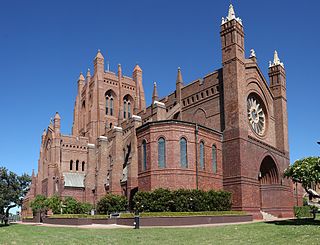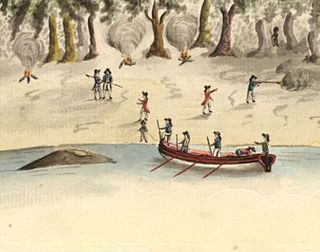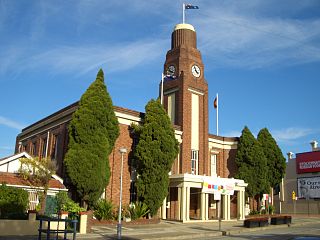
Template:Sydney Cove

Admiralty House is the Sydney official residence of the Governor-General of Australia. It is located in the suburb of Kirribilli, on the northern foreshore of Sydney Harbour. This large Victorian Regency and Italianate sandstone manor, completed in stages based on designs by James Barnet and Walter Liberty Vernon, occupies the tip of Kirribilli Point. Once known as "Wotonga", it has commanding views across Sydney Harbour to the Sydney Harbour Bridge and the Sydney Opera House.

Bennelong Point, a former island in Sydney Harbour, is a headland that, since the 1970s is the location of the Sydney Opera House in Sydney, New South Wales, Australia.
The Second Fleet was a convoy of six ships carrying settlers, convicts and supplies to Sydney Cove, Australia in 1789. It followed the First Fleet which established European settlement in Australia in the previous year.

The Castle Hill rebellion of 1804 was a rebellion by convicts against colonial authority of the British colony of New South Wales in the Castle Hill area, in Sydney. The rebellion culminated in a battle fought between convicts and the colonial forces of Australia on 5 March 1804 at Rouse Hill, dubbed the Second Battle of Vinegar Hill after the first Battle of Vinegar Hill which had taken place in 1798 in Ireland. It was the first and only major convict uprising in Australian history suppressed under martial law.
The history of Australia from 1788–1850 covers the early colonial period of Australia's history, from the arrival in 1788 of the First Fleet of British ships at Sydney, New South Wales, who established the penal colony, the scientific exploration of the continent and later, establishment of other Australian colonies.

Between 1788 and 1868, about 162,000 convicts were transported from Britain to various penal colonies in Australia.
The following lists events that happened during 1804 in Australia.

Cockle Bay is a small bay in inner-city Sydney, New South Wales, Australia. It is located on the western edge of the Sydney central business district.
George Bouchier Worgan was an English naval surgeon who accompanied the First Fleet to Australia. He made several expeditions to the Hawkesbury River and Broken Bay areas north of Sydney and spent a year on Norfolk Island after the Sirius was wrecked there. Worgan recorded many of the events of the first year of the colony of New South Wales. Unlike his contemporary Watkin Tench, he did not publish his account.

The Cathedral Church of Christ the King, also called Christ Church Cathedral, is an Australian cathedral in Newcastle, New South Wales. It is the cathedral church of the Diocese of Newcastle in the Anglican Church of Australia. The building, designed by John Horbury Hunt in the Gothic Revival style, is located on a hill at the city's eastern end in the suburb called The Hill. It was added to the New South Wales State Heritage Register on 28 June 2011.

Bridge Street is a street in the central business district of Sydney in New South Wales, Australia. Bridge Street runs for 500 metres (1,600 ft) in a west–east direction with traffic flowing in both directions. It is situated in the northern portion of the central business district. The western terminus of Bridge Street is at George Street, with the eastern terminus at Macquarie Street, adjacent to the Chief Secretary's Building.

During the Hawkesbury Settlement (1790–1816) there were a series of incidents between settlers and New South Wales Corps and the Indigenous clans of the Hawkesbury river.

The First Government House was the first residence for the Governors of New South Wales located at 41 Bridge Street, in the Sydney central business district in the City of Sydney local government area of New South Wales, Australia. It was built from 1788 to 1789 and used until 1845, after which it was demolished in 1846. Some of the site is now occupied by the Museum of Sydney. Its construction was attributed to James Bloodworth. It is also known as First Government House Site, Museum of Sydney and A Rum Rebellion Site. It was added to the New South Wales State Heritage Register on 10 December 1999; and on 19 August 2005 the site was listed on the National Heritage List.
James Scott (d.1796) was a Sergeant of Marines in the New South Wales Marine Corps and commander of the first quarter guard in New South Wales. He is notable for his journal describing his experiences in the First Fleet, which established the first European settlement in Australia in 1788.
Sarah Bellamy was a convict on The First Fleet to Australia. She was sentenced for several years transportation and was one of the longest living first fleeters.

The Fortune of War Hotel is a heritage-listed pub located at 137 George Street, in the inner city Sydney suburb of The Rocks in the City of Sydney local government area of New South Wales, Australia. It was designed by the Tooth & Co. resident architect and built in 1922 by H. J. & H. W. Thompson. The property is owned by Property NSW, an agency of the Government of New South Wales. It was added to the New South Wales State Heritage Register on 10 May 2002.

Sydney Cove West Archaeological Precinct is a heritage-listed precinct that contains The Rocks police station, the Museum of Contemporary Art Australia, car park, parks, shops and roads located at 112-156 George Street, in the inner city Sydney suburb of The Rocks in the City of Sydney local government area of New South Wales, Australia. The precinct previously contained a commissariat store, Maritime Services Board offices, dockyard and Department of Labour & Industry offices. Buildings in the precinct were developed in various stages since 1797 to date, with heritage-listed buildings dating from 1797 to 1939. The precinct is also known as the Museum of Contemporary Art, Maritime Services Board, Colonial Government naval dockyard, Commissariat Stores, Colonial Hospital, Kings and Queens Wharf and First Fleet Park. The property is owned by Property NSW, an agency of the Government of New South Wales. It was added to the New South Wales State Heritage Register on 5 August 2011.























